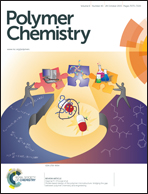Hypercrosslinked porous polymer nanosheets: 2D RAFT agent directed emulsion polymerization for multifunctional applications†
Abstract
Two-dimensional hyper-cross-linked microporous polymers (2D HCPs) have been readily synthesized by emulsion polymerization using trithiocarbonate functionalized graphene oxide as a 2D reversible addition–fragmentation chain transfer (RAFT) agent. After a gel-type and permanently porous poly(vinylbenzyl chloride-co-divinylbenzene) precursor resin was grafted to the graphene surface, an FeCl3-promoted Friedel–Crafts reaction was carried out for benzyl chloride groups to construct a porous structure confined within 2D nanosheets. The resulting HCPs exhibited superhydrophobic behavior, and had a predominance of micropores with a specific surface area of up to 1224 m2 g−1. Moreover, they showed improved thermal stability in comparison with unadorned HCPs obtained without using the graphene template. Their H2 and CO2 capacities at 77 and 273 K reached 1.27 and 9.74 wt%, respectively, at a relative pressure of 0.99. In addition, the as-synthesized 2D HCPs were used as carbon precursors to generate 2D porous carbons with a high specific surface area (871 m2 g−1) and high-performance electrochemical energy storage (144 F g−1 at 0.5 A g−1).


 Please wait while we load your content...
Please wait while we load your content...